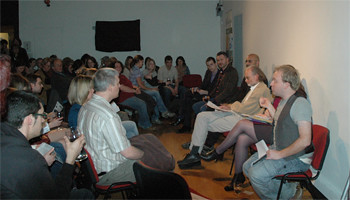The following essay is written by the Artist - Julia Thomas - and relates to the Cardiff sciSCREEN discussing the film Lars and the Real Girl.
I'm going to draw on some significant
visual aspects within the film Lars andthe Real Girl and also relate the film to an art project and gallery space
that I've been running in Roath, Cardiff. ATTIC involved art residencies,
exhibitions, discussions and events exploring how we understand the mind
personally, culturally and scientifically.
‘Lars and the Real Girl’ is a film about
loss, attachment and abandonment, loneliness, compassion, acceptance and
connecting but principally it’s about community and a collective compassion by
that community towards an individual. Our understanding and experience of life
comes about through our own personal encounters with the world but also with how
we communicate with others and how we share those encounters with others
through language, both verbal and visual. When I use the word language, I mean words,
sounds, marks or signs that hold meaning.
Although there are other examples in the
film, I’m going to draw on a particular visual reference - the colour pink, which
I found interesting both in its use as a signifier and as a means of
composition to guide us through the narrative of what Lars is experiencing. Early
on in the film Lars’ lack of a girlfriend is highlighted by his church friend
Mrs. Gruner when she gives him a pink carnation and tells him to give it to
someone nice. However, when Margo awkwardly
steps forward as someone who could potentially fulfill that role, there is that
very comical moment as Lars hurriedly throws the carnation to the floor and
runs away as fast as he can. This instantly sets up the framework of the film
to be about connecting (or not) with others and within the backdrop of
community life.
Most likely triggered by Karin’s impending
childbirth, Lars’ delusion of Bianca develops with humour and sensitivity
throughout the film; he treats her as a real person with whom he can share his
anxieties and use as a tool to enable him to confidently share his concerns
with others. The pink bedroom features heavily and this, of course, was his
mother’s bedroom who died whilst giving birth to Lars. Thus the pink comes to
represent his mother’s lingering presence in the family home but also her
absence in Lars’ life. Many of the conversations between Lars and Bianca, the
anatomically correct sex doll that becomes his girlfriend, take place within
this pink bedroom.
When Lars’ relationship with Bianca begins
to falter he goes bowling with Margo and again we see the significance of the
colour pink when the filmmakers linger on a moment in which Lars is reluctant
to let go of the bowling ball, the pink bowling
ball. This can be read as the letting go of the disconnected life he has
constructed to protect himself or is simply familiar with, possibly as a result
of his upbringing by a father saddened and incapacitated by grief and loss. Finally,
towards the end of the film, Lars prominently wears a pink carnation in his
lapel at Bianca’s funeral.
Within artworks there is often less of an
obvious narrative than within films but the use of colour, media, composition,
signifiers and different modes of presentation or experiencing the work make up
a visual language that may confer intended meaning or, more interestingly, open
up the opportunity for the viewer to develop their own reading and meaning of
the work through what they bring of themselves and their own experiences.
There are other aspects of the film I
picked up on, many of which are particularly relevant to the ethos and concept
of ATTIC and to the activities that have taken place there. The anatomically
correct sex-doll, although perfectly acceptable to Lars, is not initially
considered to be acceptable behaviour in the eyes of the community, especially
the church members or parents of young children. Contrast that with the act of
a socially acceptable form of greeting, the handshake. The handshake is
highlighted in the film by the difficulties Lars has with physical contact and
his obvious discomfort and pain of that process. Mores is a word used to define the accepted (moral) conventions of
a group or society so it is interesting how the film plays with those
perspectives and, indeed, plays with us as viewers of the film by presenting us
with a seemingly unrealistic scenario of a community that later accepts Bianca
as a ‘real girl’. Perhaps such ‘obvious’ unrealism simply echoes the schism
that exists between real life and fantasy within Lars’ delusion and allows us
to consider what we might achieve if we suspend our disbeliefs and conventions
and open up to another perspective?
A comical moment in the film is when the
pregnant Karin wrestles Lars to the ground in her frustration at being unable
to connect with him and to cope with his increasingly evasive behavior. This
takes place in the space between the family home and the garage where Lars has
been displaced. Such negotiation of ‘the private and the public’ raises issues
of safe territory and of how difficult it can be for a person to deal with
other’s lack of understanding and distress.
Another trope in the film is ‘conversation
through the act of making’; the church ladies ‘sit’ with Lars whilst Bianca is
ill and they tackle the sensitive conversation of what her illness represents, all
whilst in the act of knitting or embroidery. A creative/visual framework,
conversation through creating/making, the bringing together of different
perspectives, questioning the accepted conventions of different groups in
society and the negotiation of the private and the public are all features of
ATTIC and what it has been exploring. There is soon to be a short documentary
film about the project but you can see some of the activity that took place by
searching on facebook.com/cardiffATTIC.








No comments:
Post a Comment